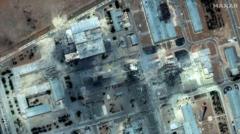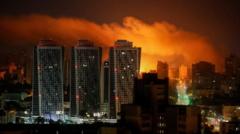The Pentagon confirms severe damage to multiple Iranian facilities while the overall impact on Iran's nuclear capabilities remains unclear.
Pentagon Launches Precision Strikes on Iranian Nuclear Facilities

Pentagon Launches Precision Strikes on Iranian Nuclear Facilities
U.S. military executes covert operation against Iran’s key nuclear sites in a decisive move amidst rising tensions.
In a significant military operation, high-ranking Pentagon officials unveiled details regarding a coordinated strike against Iranian nuclear facilities on Sunday. Defense Secretary Pete Hegseth and General Dan Caine, chairman of the Joint Chiefs of Staff, characterized the operation—dubbed “Operation Midnight Hammer”—as a testament to the United States military's capabilities in modern warfare. However, amidst the discussions, they did not clarify whether Iran retains the capacity to develop nuclear weapons following the attack.
During a press briefing, Secretary Hegseth echoed President Trump's earlier affirmation that the nuclear sites had been “obliterated,” while General Caine remained cautious, noting that a comprehensive damage assessment is pending. Initial reports suggest that all three targeted sites—Fordo, Natanz, and Isfahan—sustained considerable destruction.
The meticulously planned strikes commenced from Whiteman Air Force Base in Missouri, using B-2 stealth bombers that undertook a lengthy journey spanning over 7,000 miles, with several aerial refueling stops necessary for the mission. The bombers carried out their strikes within a remarkably short timeframe, hitting the heavily fortified site at Fordo and other critical facilities at Natanz during a window of just 25 minutes on Saturday evening.
General Caine emphasized that the detailed analysis of the operation’s aftermath will take some time to complete, but initial evaluations already indicate that the impact was substantial. As the situation develops, the world watches closely to understand the implications for regional stability and whether Iran's nuclear ambitions have been decisively curtailed.
During a press briefing, Secretary Hegseth echoed President Trump's earlier affirmation that the nuclear sites had been “obliterated,” while General Caine remained cautious, noting that a comprehensive damage assessment is pending. Initial reports suggest that all three targeted sites—Fordo, Natanz, and Isfahan—sustained considerable destruction.
The meticulously planned strikes commenced from Whiteman Air Force Base in Missouri, using B-2 stealth bombers that undertook a lengthy journey spanning over 7,000 miles, with several aerial refueling stops necessary for the mission. The bombers carried out their strikes within a remarkably short timeframe, hitting the heavily fortified site at Fordo and other critical facilities at Natanz during a window of just 25 minutes on Saturday evening.
General Caine emphasized that the detailed analysis of the operation’s aftermath will take some time to complete, but initial evaluations already indicate that the impact was substantial. As the situation develops, the world watches closely to understand the implications for regional stability and whether Iran's nuclear ambitions have been decisively curtailed.





















